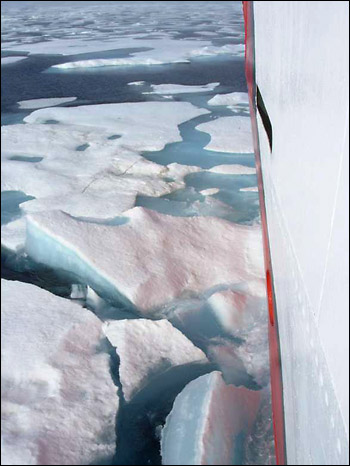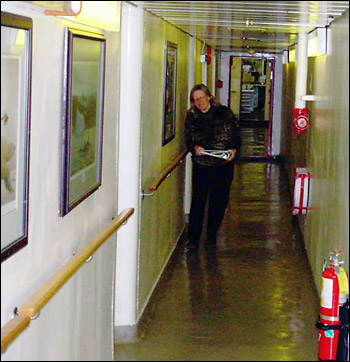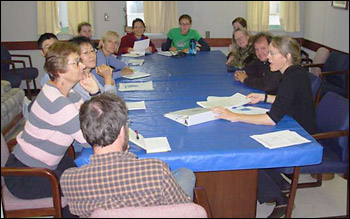Please note: You are viewing
the unstyled version of this website. Either your browser does not support CSS
(cascading style sheets) or it has been disabled. Skip
navigation.
Rick KrishfieldAugust 8, 2006
In fact, most icebreakers do not break ice by ramming (with the exception of the Russian nuclear icebreakers), but typically break ice by riding up over the ice, and using the weight of the ship to crack the floes. As a result the design of the hull is more rounded than most vessels, which means that the ship will also roll more in ice-free high seas. Anyone who has felt the rolling motion of an icebreaker in heavy seas would prefer the herky-jerky motion of the icebreaker in the ice. On this day, we encounter highly concentrated relatively thick (3 m) multi-year ice (ice that has survived over at least one complete summer season) over the location of the CABOS mooring that we planned to recover. This is rather surprising, since very little ice has been encountered at this location during the past three summer cruises; although not too surprising, as we were warned of this possibility by the onboard Ice Observer Scott Payment, who analyzes daily satellite images of the icepack for navigational purposes (to see an example of satellite ice images, visit the Alaska Ocean Observing System website). Using an acoustic transponding device, Mike Dempsey and myself were able to verify the location and integrity of the instrumented mooring system, but the ice conditions prohibited recovery on this pass. We will try again near the end of the cruise, on our way back to Kugluktuk. Meanwhile, the CTD and chemistry group meet in the ship's boardroom so that Chief Scientist Sarah Zimmermann (from IOS, Canada) can pass along information on the timing and work to be performed at the next CTD station. This is the third year that Sarah has skillfully lead the international team of scientists on the annual JWACS cruise. Besides coordinating the various scientific activities which all clamor for shiptime, and coordinating on behalf of the scientists with the Captain and ship's officers, Sarah also leads the CTD operations. I don't know how she manages to stay so pleasant with all these responsibilities heaped upon her. Last updated: October 7, 2019 | |||||||||||||||||||
Copyright ©2007 Woods Hole Oceanographic Institution, All Rights Reserved, Privacy Policy. | |||||||||||||||||||





